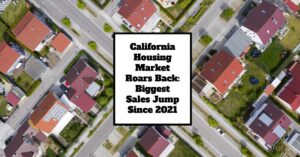These top 20 Hottest Housing Markets for 2025 not only highlight areas of growth but also provide insights into the ever-evolving dynamics of the U.S. housing landscape. With regions in the South and West demonstrating robust potential, these markets are set to benefit from a myriad of factors including demographic shifts, economic growth, construction trends, and favorable financing options.
Let's dive deep into each of these markets, exploring the underlying elements that position them as front-runners for homebuying activity. This article draws upon data and insights provided by Realtor.com, including expert opinions and market analysis, to explore the hottest housing markets for 2025.
Key Takeaways
- Geographic Concentration: The hottest housing markets are predominantly found in the South and West.
- Young and Diverse Demographics: Many of these regions feature youthful populations, which increases demand for housing.
- Government-Backed Support: The prevalence of government-backed mortgage programs improves accessibility to home ownership.
- Significant New Construction: The ongoing development of new homes is crucial for addressing longstanding housing shortages.
- Attractive Affordability: Various markets remain relatively affordable, making them appealing to a broad spectrum of buyers.
The Sun Belt's Continued Dominance
The Sun Belt, a region encompassing the southern tier of states, continues to dominate the housing market landscape. Warm weather, expanding job opportunities, and a lower cost of living have made states like Texas, Florida, and Virginia hot spots for prospective homeowners and investors alike. Cities such as Colorado Springs, Miami, Virginia Beach, and others within these states are poised for significant increases in home sales and price appreciation in 2025.
Top 20 Hottest Housing Markets Predicted for 2025
- Colorado Springs, CO
- Expected Sales Growth: 27.1%
- Median Home Price Increase: 12.7%
- Key Factors: A sizeable military presence, with 31.4% of households connected to the armed forces, drives demand. The area's scenic beauty and robust outdoor recreational opportunities also appeal to younger families.
- Miami, FL
- Expected Sales Growth: 24.0%
- Median Home Price Increase: 9.0%
- Key Factors: Miami’s international appeal, bolstered by a diverse cultural landscape, attracts both domestic and foreign buyers. The real estate market benefits from a healthy mix of high-value properties and more affordable housing options.
- Virginia Beach, VA
- Expected Sales Growth: 23.4%
- Median Home Price Increase: 6.6%
- Key Factors: Beyond its military significance, Virginia Beach offers a family-friendly environment with excellent schools and recreational facilities, making it attractive for homebuyers seeking stability.
- El Paso, TX
- Expected Sales Growth: 19.3%
- Median Home Price Increase: 8.4%
- Key Factors: An impressive 61.7% of homeowners in El Paso own their homes debt-free, reducing the impact of mortgage rate concerns. Its unique market conditions make it resilient despite fluctuating national trends.
- Richmond, VA
- Expected Sales Growth: 21.6%
- Median Home Price Increase: 6.1%
- Key Factors: Fueled by a flourishing tech scene and revitalized urban areas, Richmond attracts young professionals and families alike. The city's expansion is reflected in ongoing developmental projects that cater to diverse housing needs.
- Orlando, FL
- Expected Sales Growth: 15.2%
- Median Home Price Increase: 12.1%
- Key Factors: As a key tourist destination, Orlando's economy enjoys robust growth. The city’s excellent schools and family-friendly attractions are drawing in new residents, while the construction of new homes continues ramping up.
- McAllen, TX
- Expected Sales Growth: 19.8%
- Median Home Price Increase: 7.0%
- Key Factors: McAllen boasts a significant percentage of homeowners without mortgages, enhancing stability within the market. Its low cost of living and desirable climate fortify its attractiveness to new buyers.
- Phoenix, AZ
- Expected Sales Growth: 12.2%
- Median Home Price Increase: 13.2%
- Key Factors: The rapid influx of people to Phoenix from other states drives demand for housing. The city has embraced a diverse economy, including tech jobs, which means ongoing job creation and price increases.
- Atlanta, GA
- Expected Sales Growth: 15.1%
- Median Home Price Increase: 10.2%
- Key Factors: Atlanta thrives on its vibrant cultural scene and job opportunities, especially in technology and media. The city's progressive environment is attracting young professionals and families looking for growth.
- Greensboro, NC
- Expected Sales Growth: 17.3%
- Median Home Price Increase: 7.7%
- Key Factors: Affordability is Greensboro’s major draw, coupled with a burgeoning job market. The city's attractive suburban lifestyle and access to good schools further enhance its appeal.
- Tucson, AZ
- Expected Sales Growth: 12.5%
- Median Home Price Increase: 12.4%
- Key Factors: Southern Arizona’s appeal lies in its natural beauty and historic charm. The city has been actively expanding its housing inventory to keep up with growing demand while focusing on affordability.
- Austin, TX
- Expected Sales Growth: 14.5%
- Median Home Price Increase: 10.2%
- Key Factors: Renowned for its booming tech sector, Austin attracts both startups and established businesses. The city's cultural scene, along with extensive parks and lakes, encourages homebuyers looking for a vibrant lifestyle.
- Durham, NC
- Expected Sales Growth: 14.1%
- Median Home Price Increase: 10.1%
- Key Factors: Connected to the Research Triangle, Durham's presence of top universities and hospitals fuels housing demand substantially. Its unique blend of urban and suburban living appeals to varied demographics.
- Charlotte, NC
- Expected Sales Growth: 15.7%
- Median Home Price Increase: 8.4%
- Key Factors: As a significant financial hub, Charlotte's strong economy and job growth rates position it as an attractive destination for people relocating within the region. Its upward trajectory is likely to continue into 2025.
- Little Rock, AR
- Expected Sales Growth: 18.6%
- Median Home Price Increase: 4.8%
- Key Factors: Little Rock offers a friendly community atmosphere alongside lower home prices compared to national averages, making it an appealing option for families.
- Jacksonville, FL
- Expected Sales Growth: 13.5%
- Median Home Price Increase: 9.8%
- Key Factors: With its extensive coastlines, Jacksonville offers a desirable lifestyle for many incoming residents. The balanced job market and entertainment options continue to create an attractive environment for buyers.
- Cape Coral, FL
- Expected Sales Growth: 13.2%
- Median Home Price Increase: 9.6%
- Key Factors: Cape Coral’s reputation for beautiful waterfront properties and strong fishing and boating opportunities uniquely positions it among desirable locations for retirees and families alike.
- Washington, DC Area
- Expected Sales Growth: 17.0%
- Median Home Price Increase: 5.0%
- Key Factors: Anchored by government jobs and educational institutions, the DC market has proven resilient. Its diverse culture and vibrant community make it attractive to various demographics.
- Harrisburg, PA
- Expected Sales Growth: 16.8%
- Median Home Price Increase: 5.1%
- Key Factors: Known for its historical significance, Harrisburg provides affordable living combined with easy access to larger metropolitan areas, enhancing its attractiveness for commuters.
- Denver, CO
- Expected Sales Growth: 13.6%
- Median Home Price Increase: 8.0%
- Key Factors: With its scenic surroundings and art scene, Denver is a major draw for young professionals. The city's economic growth and lifestyle options continue to push demand in its housing sector.
Driving Forces Behind Market Growth
Improved Inventory Levels
An increase in housing inventory is paramount for a stable housing market. Many of the top-ranked cities are witnessing a recovery in existing home sales, alongside a significant uptick in new constructions. The latest trends indicate that home builders are focusing on smaller, more affordable homes to meet the newly emerging demands of prospective buyers.
Government Assistance Programs
Government-backed loans, including VA, FHA, and USDA, play a crucial role in supporting home purchases. These programs have allowed buyers in many of these markets to enter the housing market with lower down payments, further enhancing affordability. As the average down payment required for homes in these markets is often significantly lower than the national average, more individuals can take advantage of homeownership.
Demographic Changes
Targeting younger families and individuals, a majority of the cities in this list possess significant populations under the age of 35. According to Realtor.com, regions like McAllen and Colorado Springs possess above-average shares of households with children, indicating sustained demand. As life changes spur household growth—like marriage, children, or job relocations—these areas are poised for increased home sales.
Migration Patterns
The ongoing trend of migration toward affordable and desirable living conditions has affected regional housing markets. People moving to warmer climates with access to better job opportunities are continuing to reshape demographics, particularly in the Sun Belt. Regions with relaxed regulations on remote work further enable this trend, allowing more flexibility in where individuals choose to settle.
Robust Economic Conditions
Economically strong regions create attractive markets for housing, especially where job opportunities are plentiful. Many cities on the list are tied to major industries such as technology, healthcare, and finance, which contribute to the local job sectors and foster a steady influx of new residents. A strong labor market is often synonymous with increased home sales, as higher employment levels typically correlate with improved consumer confidence.
Conclusion
The Top 20 Hottest Housing Markets for 2025 showcase significant potential for future growth, driven by a confluence of favorable demographics, economic prosperity, and government support. As we look ahead, it is clear that areas in the South and West will continue to attract attention from homebuyers seeking value and opportunity. Whether influenced by military ties, job availability, or international investment, these markets are uniquely positioned to thrive in American real estate.
Work with Norada in 2025, Your Trusted Source for
Turnkey Real Estate Investing
Discover high-quality, ready-to-rent properties designed to deliver consistent returns.
Contact us today to expand your real estate portfolio with confidence.
Contact our investment counselors (No Obligation):
(800) 611-3060
Recommended Read:
- 5 Hottest Real Estate Markets for Buyers & Investors in 2025
- Hottest Real Estate Markets in Maine: Top Locations for 2024
- 20 Hottest Housing Markets in the US – September 2024
- The Hottest Housing Markets in Seattle Area (2024)
- America's 20 Hottest Housing Markets: July 2024 Rankings
- Top 10 Hottest Real Estate Markets in the World
- Hottest Housing Markets Predicted for 2024
- Zillow’s Predictions for the Hottest Housing Markets of 2024
- 68 Housing Markets Where Prices Have Doubled the Fastest
![Top 20 Hottest Housing Markets Predicted for the Next Year [2025]](https://www.noradarealestate.com/wp-content/uploads/2024/07/hottest-housing-markets-2025-300x157.jpeg)










